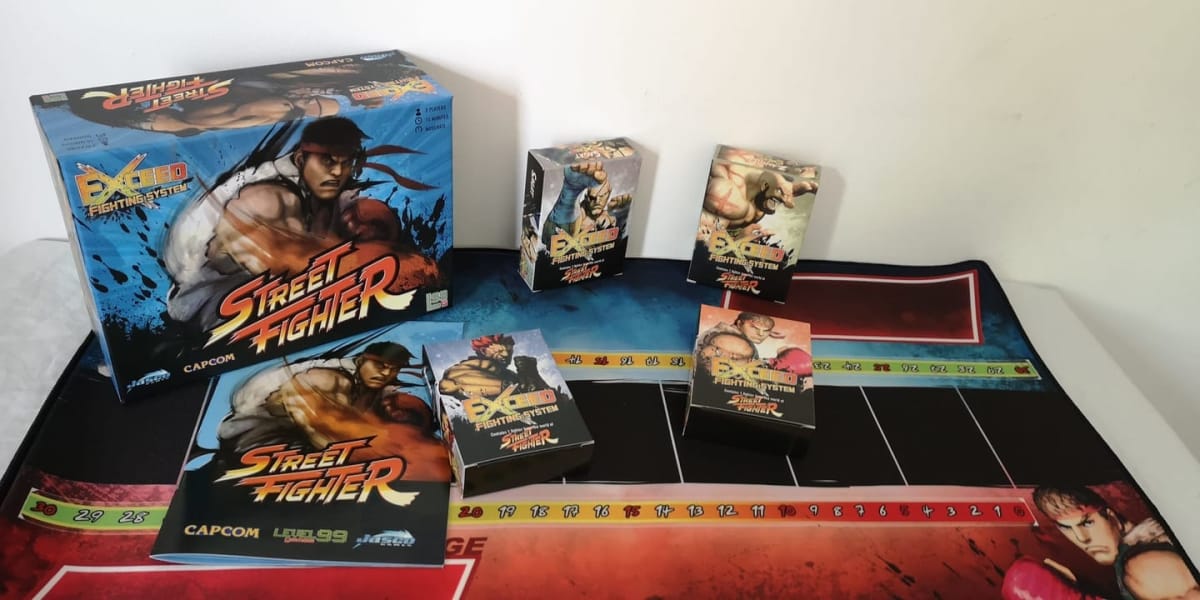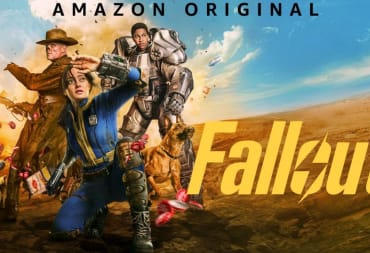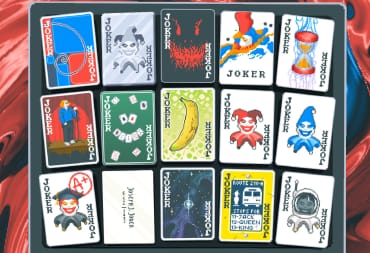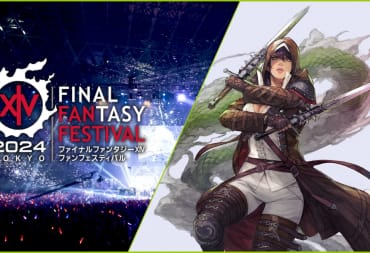Our Video to Tabletop series is back for 2019! Last year we looked at three different tabletop games that had come from video-game franchises. We first looked at wargaming, with our focus on Fallout: Wasteland Warfare. Our next stop was board games with Dark Souls: The Board Game and we finished with card games looking at Boss Monster. This year we're going to flip it around, and we're starting with the card game with Street Fighter Exceed!
In our Video to Tabletop articles, we look into the development process of making a video game into a tabletop game. We'll talk about why more and more IPs are moving into the tabletop genre. We'll look at video game IP tabletop games and talk to development teams about the difficulties of bringing a video game to life on the tabletop.
In this article, we'll take a look at the one of the new Street Fighter Exceed sets, as well as seeing how the video game theme transitions to the tabletop. We will also talk to D. Brad Talton Jr., the designer of Street Fighter Exceed.
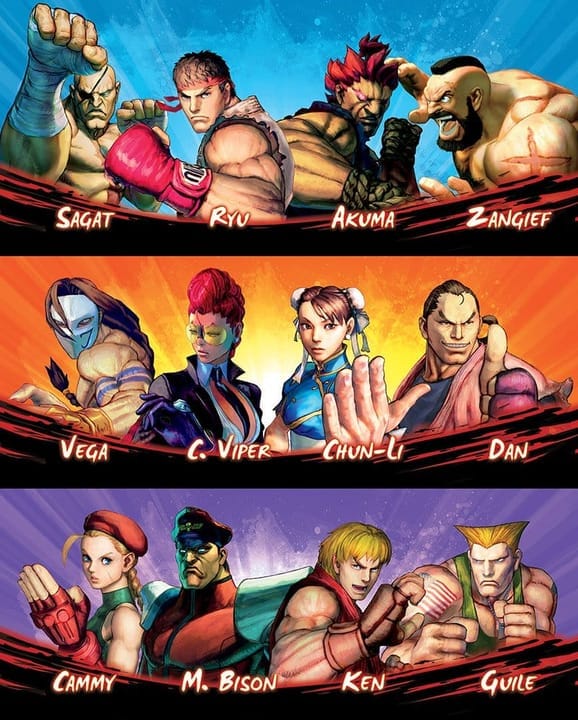
Street Fighter Exceed
Street Fighter Exceed is the third release under the Exceed Fighting System from Level 99 Games. The Exceed Fighting System began with Red Horizon and Seventh Cross. Exceed pits two fighters against each other, and with Street Fighter Exceed, you can battle with 12 famous Street Fighter characters.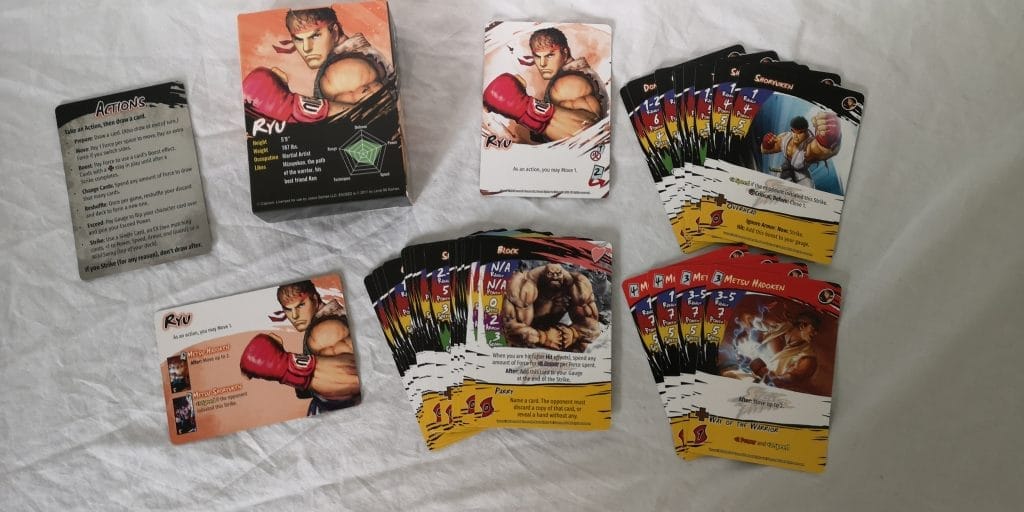
Fighters in Street Fighter Exceed have fixed decks. These decks are made up of 8 normal attacks, which all fighters have and then 5 character specific special attacks and 2 ultra attacks. Two copies of each of these cards make up a 30 card deck.
The game is played on a nine-card-long track. You can also purchase a special playmat, which has the arena spaces, along with a health track and gauge area.
[gallery columns="2" size="large" ids="292498,292497"]
During the game, cards are spent to perform all actions and you only draw a card if you did not strike. This makes the card currency of the cards in your hand very important. If you want to move on the track, you need to spend cards to do so in order to position yourself for strikes later. Fighters can take a prepare action, which allows you to draw an extra card on top of the card for not striking, or you can discard cards from your hand to generate force to draw cards.
It’s a very interesting mechanic, and it makes timing and range in your plays very important. Something that has carried through from the video game.
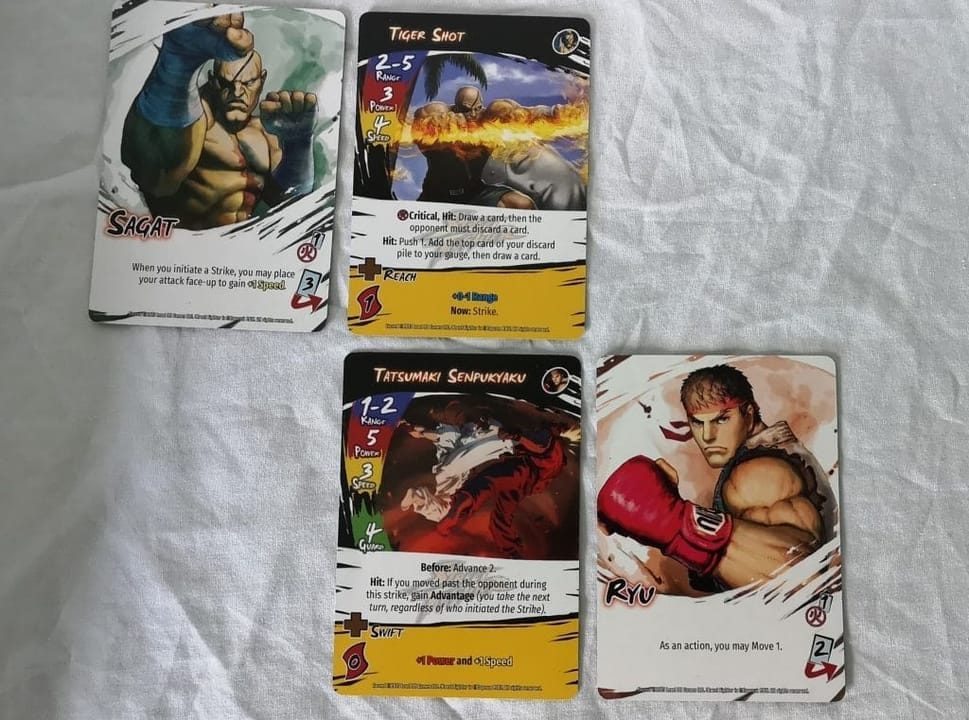
When you strike, you and your opponent both play cards. Out of the played cards, the attack with the highest speed goes first. So even though you attacked your opponent, they may get to strike first.
Every attack has a range which you have to be within to be able to strike. Some attacks let you move before the strike with special trigger effects, which can, in turn, affect the range of your opponent’s attack, or your own if they attack first.
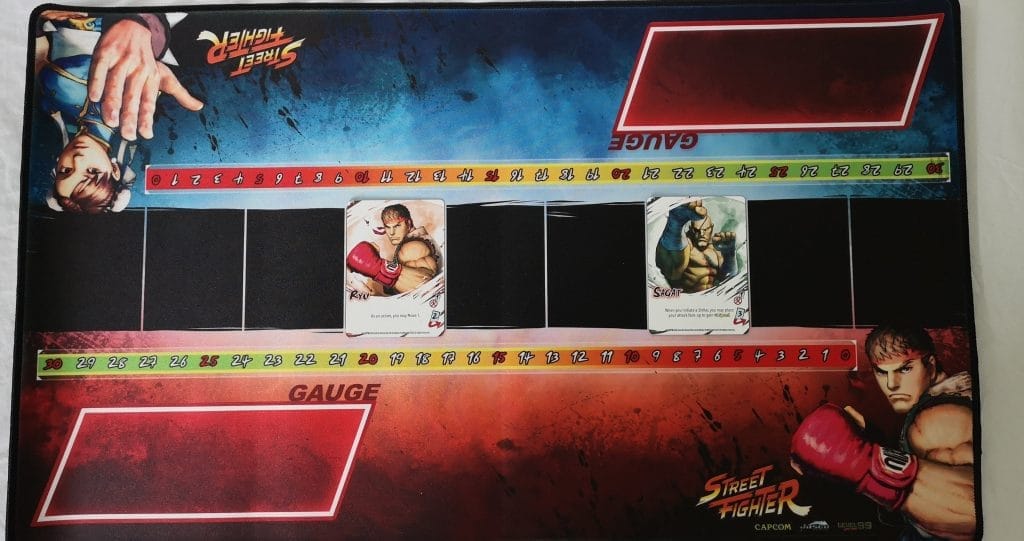
The power of the attack is the damage it causes to your opponent, but this can be reduced by armor on their strike card. The remaining damage is dealt to their health. If the damage dealt is over the Guard of your opponent’s card, they are also stunned. Stunned is only relevant if you are striking second in this attack, because being stunned means that your character won’t perform their attack this round.
All of the above needs to be taken into consideration when choosing your attack. A fast attack with a low guard and armor has more chance of going first, but if your opponent’s strike is faster, you might not get to attack. A strong attack with a low speed, but high armor and Guard might have to wait to strike second, but should be able to weather the storm of your opponent’s attack in order to deal damage back.
Range is very important. If your attack is out of range, it will fail. If your attack is Range 1 and your opponent gets to strike first, they amight be able to move our of range of your attack with a trigger move or special ability.
[gallery columns="2" size="large" ids="292503,292504"]
Attacks can be upgraded to an EX Attack by playing two copies of the strike. This adds +1 power, speed armor and guard to the attack.
If your strike succeeds, you can put the card into your Gauge area. Gauge can be spent as force to draw cards and move, but it can also be spent to play the powerful Ultra Attacks, which all have their own Gauge cost.
Guage can also be spent to flip your character over from its starting side to the Exceed side. All character has an ability printed on their character card, and when they power up to Exceeded, their ability improves. Ryu, for example, can normally move 1 as an action, but after his character Exceed’s, he can move 1 and draw 1 card as an action.
Knowing your character and your opponent's character, in what attacks they have available and what range they operate best at is a huge part of Street Fighter Exceed. Something that has carried directly across from the competitive side of the video game.
[gallery columns="2" size="large" ids="292501,292502"]
All of the characters, because of their individual strike cards and their fixed ability, do feel unique. We were surprised because each of their decks are made up of over 50% of the same cards. Only 14 out of the 30 cards are unique for each character and yet they all have their own style of play.
In the box we tested with Ryu, Akuma, Sagat, and Zangief, they all had very unqiue styles of play. Ryu is a versatile fighter who can work at all ranges. He’s not hugely powerful, but he always has options. Sagat is a ranged fighter who can push out some incredible speed strikes. Zangief is a very powerful fighter, but only at close range and Akuma is a combo fighter who has options in regards to adding risk and rewards to his attacks.
There are currently three Street Fighter Exceed packs available, each with 4 different fighters. We would also encourage players to get the play mat. It’s not only a great playing surface, but it helps play and really captures the feel of the video game. The only thing missing is the stage music.

Street Fighter Exceed Developer Interview
We spoke to D. Brad Talton Jr., the Designer of Street Fighter Exceed about the development process and difficulties in bringing a video game to the tabletop.TechRaptor: It feels like a lot of effort was put into the feel of the 2D fighting game. How important was that in the initial design for Exceed?
Brad: It's very easy in design to get caught up in simulating the deep mechanics of such a game. We had to make it clear from the beginning that flow and playability were more important than an exact replication.This is why things like high and low attacks (which existed in early versions of Exceed) were taken out of the game. Concepts like Frame Advantage were compressed down into keywords, and the idea of a sequence of block and counter-attack were merged into one card, rather than forcing players to assemble two cards.
The most important thing is that the fight flows and that there is the tension of imminent action at every moment of play.
TR: Were there certain elements you needed to get across, like range and the way movement feels?
Brad: Absolutely. Designing the interactions of the many fireballs was a fun challenge in Exceed. This is another place where the critical mechanic really shines. Ken's fireball won't beat certain other projectiles, but when you use the powered-up version, that changes everything. We also wanted to make fireballs spammable (in a fair way), wherever it made sense for characters. This allows you to create situations where the opponent has to 'get in' over your fireball trap, much like in SF.TR: Was anything left out of the game because it didn’t feel right or act right mechanically?
Brad: In this game, you are able to Exceed by flipping your character over and gaining access to a more powerful ability. This is very similar to the V-Trigger in SFV, or the mode changes that some characters have access to in SF4 and Third Strike. In the game, these abilities wear off after a while. However, the concept of a timer in a card game is clunky and requires lots of upkeep. We decided it was healthier for the game's play style to make these upgrades permanent.TR: What was more important, video game feel or mechanics?
Brad: The most important thing is the big identity of the characters and the feelings that the game creates. We definitely didn't want to get into the low-level mechanics of Street Fighter's Engine or gameplay. We wanted to capture the identity of the game and its characters and adapt them to the tabletop medium we know and love.When you play Ken, whether it's in SF4 or in SFV or in Exceed, you know you're going to be playing a slightly power-tuned rushdown fighter with an excellent Shoryuken. Our goal in each fighter's design is to uphold the promise that Capcom has made with their identity across the SF games: if you pick this fighter, you get this experience.
TR: What was it like working with Capcom on the project?
Brad: We were generally free to do what we wanted and interpret the characters according to our vision. We were even able to include a few in-jokes for fans of the series. For example, M. Bison has a skill called 'Bison Dollars', which is a callback to the old movie where he was played by Raul Julia. I was happy that Capcom approved these kinds of homages.TR: The art is great throughout Street Fighter Exceed. How closely did you work with Capcom and the artists?
Brad: Not at all, actually. Capcom has a huge repository of art from their partnerships with Udon Comics, so we were able to pick and choose art from their many art books, comics, and even some of the in-game art from the past Street Fighter titles.TR: How did you go about with the design process for each fighter along with making them feel unique? Were there certain elements you needed to get across for each character?
Brad: It wasn't anything too technical, really. I'm a long-time SF player, so I know the identity of all the core characters very well. I just sat down in the training room of SF4 and played each character and made sure I was getting the 'shape' of all their moves right (how fast, what properties, what kind of reach, how much damage, etc). I also watched a lot of gameplay videos on youtube, and referenced databases on Eventhubs.com and Shoryuken.com when designing the initial draft of the game.TR: What’s the future for Street Fighter Exceed and the Exceed line as a whole?
Brad: We're planning more SF Exceed for the next two years, so look out for a bunch more fighters from all different generations of the franchise! Between Street Fighter releases, we have a few other licenses, both original and well-known, that we'll be introducing. Look out for announcements about these on our website soon!TR: Which is your favorite Street Fighter game?
- Brad (Designer): Not everyone loves it, but I really thought that Third Strike was a high point in the series.
- Kier (Playtester): SFV
- Daniel (Playtester): I liked the final version of 4 quite a bit, though I enjoy 3S also
- Josh (Press Manager): SFV I guess because it's the one I've played the most? I've only played 4 and 5 so far.
- Laura (Graphic Designer): I was never a player, so I've mostly just enjoyed the character designs.
- Chris (Marketing Director): Third Strike
TR: Who is your favorite Street Fighter character?
- Brad (Designer): I've really enjoyed Elena. She didn't make it into this season, but I think she will make an appearance in future Street Fighter Exceed products.
- Kier (Playtester): M. Bison
- Daniel (Playtester): Juri, Gief
- Josh (Press Manager): Either Area or Karin.
- Laura (Graphic Designer): Cammy, of course!
- Chris (Marketing Director): Cody
TR: Which is your favorite Street Fighter special move (in the video game and Exceed)?
- Brad (Designer): Gadoken! It's so different from all the other fireballs in the game and allows for interesting uses.
- Kier (Playtester): Bison's Sliding Kick
- Daniel (Playtester): Zangief's Spinning Piledriver in both Exceed and SF. Metsu Shoryuken is probably my favorite super.
- Josh (Press Manager): Kanzuki-Ryu Hadorokushiki Hasha No Kata
- Chris (Marketing Director): Ryu's Collarbone Breaker
TR: Which is your favorite Street Fighter level theme (soundtrack)?
- Brad (Designer): Everything is better with Guile's theme in the background.
- Kier (Playtester): Balrog Theme
- Josh (Press Manager): Guile's theme
- Chris (Marketing Director): Ryu's Theme
TR: Thank you very much to you and the team Brad for taking the time to answer our questions.
The copy of Street Fighter Exceed used in this article was provided by Level 99 Games.
What's your favorite tabletop video game? What do you think of the Street Fighter Exceed mechanics? Who's your favorite Street Fighter character? Let us know in the comments below.
Have a tip, or want to point out something we missed? Leave a Comment or e-mail us at tips@techraptor.net
